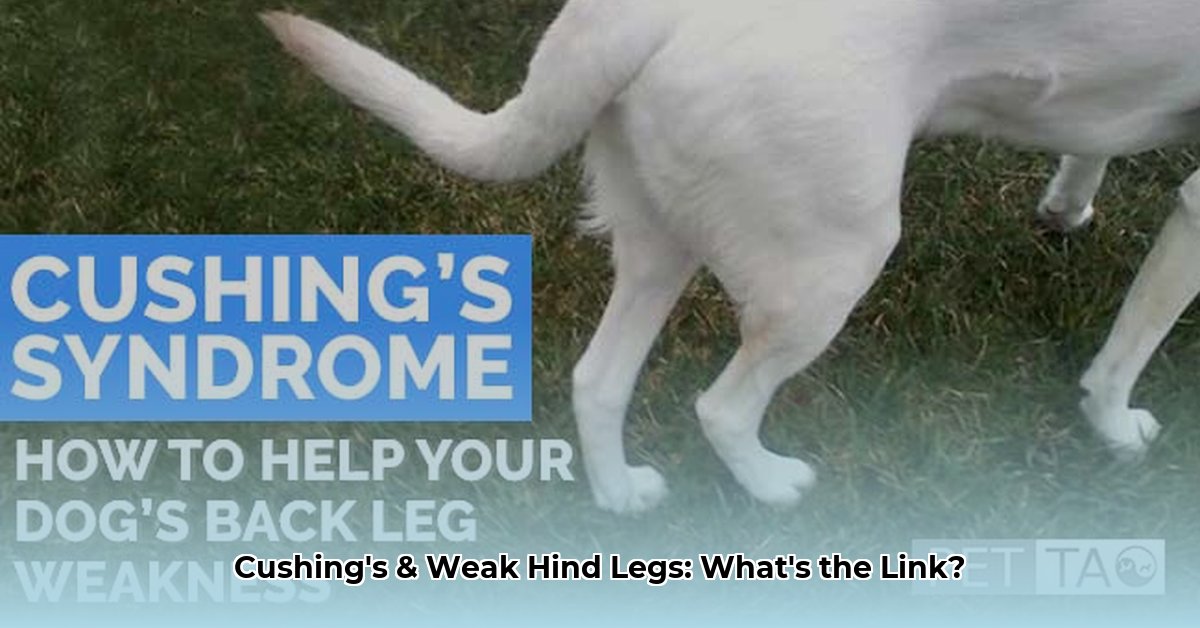Understanding Cushing’s and Its Impact on Mobility
Seeing your dog struggle to rise, walk, or enjoy their usual activities can be deeply concerning, especially when their once-strong hind legs now seem weak and wobbly. One potential culprit behind this distressing change could be Cushing’s syndrome (hyperadrenocorticism), a hormonal disorder. This comprehensive guide explains how Cushing’s can affect your dog’s mobility, offering practical advice for diagnosis, treatment, and at-home care.
The Cushing’s Connection: Why Hind Legs Wobble
Cushing’s syndrome arises from an overproduction of cortisol, a hormone crucial for stress response and metabolism. While essential in normal amounts, excessive cortisol can have detrimental effects, particularly on muscle tissue. Imagine cortisol as a powerful engine – necessary for running a car, but if it revs too high for too long, it can damage the vehicle. Similarly, too much cortisol wreaks havoc on a dog’s system. It disrupts the natural process of protein synthesis, meaning the body struggles to build and maintain muscle mass effectively. Essentially, the excess cortisol acts like a destructive force, breaking down muscle tissue faster than the body can repair it. This leads to muscle wasting (atrophy), most noticeable in the hind limbs, leading to difficulty standing, walking, and jumping. In addition to muscle wasting, Cushing’s can also weaken connective tissues like ligaments and tendons, further compromising stability and increasing the risk of injuries like cruciate ligament tears.
Spotting the Signs: Is it Cushing’s?
While only a veterinarian can diagnose Cushing’s, recognizing potential signs can help you seek timely professional advice. These symptoms can be subtle and develop gradually, so vigilance is key. Some common indicators include:
| Symptom | What You Might See |
|---|---|
| Hind Leg Weakness | Difficulty rising, wobbly gait, reluctance to jump, buckling legs. |
| Muscle Wasting | Noticeable thinning of muscles, especially in the hindquarters (thighs and hips). |
| Pot Belly | Abdominal distension due to fat redistribution and weakened abdominal muscles. |
| Increased Thirst & Urination | Frequent trips to the water bowl and increased urination. |
| Increased Appetite | Increased hunger, sometimes accompanied by weight loss due to muscle wasting. |
| Increased Panting | Difficulty regulating body temperature, leading to excessive panting even without exertion. |
| Thinning Skin/Hair Loss | Skin becomes fragile and prone to bruising; symmetrical hair loss, often on the flanks and belly. |
| Lethargy | Decreased energy levels, reluctance to exercise, and overall increased fatigue. |
| Recurrent Infections | Weakened immune system makes dogs more susceptible to skin and urinary tract infections. |
| Behavioral Changes | Increased anxiety, restlessness, panting, or irritability. |
Diagnosing Cushing’s: The Vet’s Toolkit
If you suspect Cushing’s, your veterinarian will perform a comprehensive examination and recommend specific tests, including:
- Blood and Urine Tests: These provide a general health overview and may reveal abnormalities suggestive of Cushing’s.
- ACTH Stimulation Test: This measures how the adrenal glands respond to ACTH, a hormone that stimulates cortisol production.
- Low-Dose Dexamethasone Suppression (LDDS) Test: This test helps differentiate between pituitary-dependent Cushing’s (the most common form) and adrenal-dependent Cushing’s.
- Imaging (X-rays, Ultrasound): May be used to visualize the adrenal glands and identify potential tumors.
Treatment Strategies: Managing Cortisol Levels
Cushing’s treatment focuses on managing excessive cortisol production. Options include:
- Mitotane (Lysodren): A medication that selectively destroys cortisol-producing cells in the adrenal glands. Requires careful monitoring and dose adjustments.
- Trilostane (Vetoryl): Inhibits an enzyme crucial for cortisol production. Generally well-tolerated, but regular monitoring is still necessary.
- Surgery: In rare cases where a tumor on an adrenal gland is the cause, surgical removal may be an option.
Supporting Your Dog at Home: A Practical Guide
Managing Cushing’s effectively involves a combined approach of veterinary care and at-home support. Consider these practical tips:
1. Tailored Exercise: Gentle & Consistent
- Consult a Professional: Your veterinarian or a certified canine rehabilitation therapist can create a safe and effective exercise plan.
- Low-Impact Activities: Short, frequent walks on level ground, swimming (if tolerated), and gentle range-of-motion exercises are ideal.
- Listen to Your Dog: Respect their limits and avoid pushing them too hard. Stop and rest if they show signs of fatigue or discomfort.
2. Physical Therapy: Professional Guidance
- Targeted Exercises: A canine rehabilitation therapist can guide you through exercises to rebuild muscle strength, improve balance, and increase flexibility.
- Other Modalities: Massage, hydrotherapy, and acupuncture may also be beneficial.
3. Assistive Devices: Lending a Paw
- Harnesses & Slings: Provide support and prevent falls, especially for dogs with significant hind leg weakness.
- Ramps & Steps: Make navigating stairs, furniture, and vehicles easier.
- Orthopedic Beds: Offer cushioning and support for aching joints. You can find suitable options at reputable pet supply stores.
4. Nutrition: Fueling Recovery
- Balanced Diet: Your veterinarian or a veterinary nutritionist can recommend a diet that supports muscle health and overall well-being.
- Supplements: Discuss with your veterinarian if supplements, such as omega-3 fatty acids or antioxidants, might be beneficial.
5. Adapting Your Home: Creating a Safe Haven
- Easy Access: Ensure food, water, and resting areas are easily accessible.
- Raised Bowls: Reduce strain on the neck and back during meals.
- Non-Slip Surfaces: Prevent slips and falls on smooth floors with rugs or mats.
Prognosis and Long-Term Outlook
Cushing’s is a chronic condition requiring lifelong management. While a cure is unlikely in most cases, with diligent treatment and supportive care, many dogs can maintain a good quality of life for years. Regular veterinary check-ups are essential to monitor progress, adjust treatment as needed, and address any new challenges.
Emotional Support: You’re Not Alone
Caring for a dog with Cushing’s can be emotionally challenging. Connect with online support groups or local resources to share experiences and find encouragement. Open communication with your veterinarian is crucial; they can provide guidance and support throughout this journey.
Frequently Asked Questions (FAQ)
- Q: Can Cushing’s be cured? A: While a cure is uncommon, effective management can significantly improve a dog’s quality of life.
- Q: How long can a dog live with Cushing’s? A: With proper treatment and care, dogs with Cushing’s can live for several years after diagnosis.
- Q: What are the first signs of Cushing’s in a dog? A: Increased thirst and urination, increased appetite, and a pot-bellied appearance are often early indicators.
Conclusion
Cushing’s syndrome can significantly impact a dog’s mobility, particularly in their hind legs. By understanding the disease process, recognizing the signs, and working closely with your veterinarian, you can provide your dog with the best possible care and support their journey towards improved comfort and well-being.
Disclaimer: This information is for educational purposes only and does not constitute veterinary advice. Always consult with your veterinarian for diagnosis and treatment recommendations for your pet.
- Healthy Bento Lunch Ideas for Adults to Enjoy Lunch Again - December 22, 2025
- Glass Lunch Box Containers Offer Healthy, Leak-Proof Meal Prep - December 21, 2025
- Glass Bento Boxes Offer a Healthy, Eco-Friendly Lunch Solution - December 20, 2025










